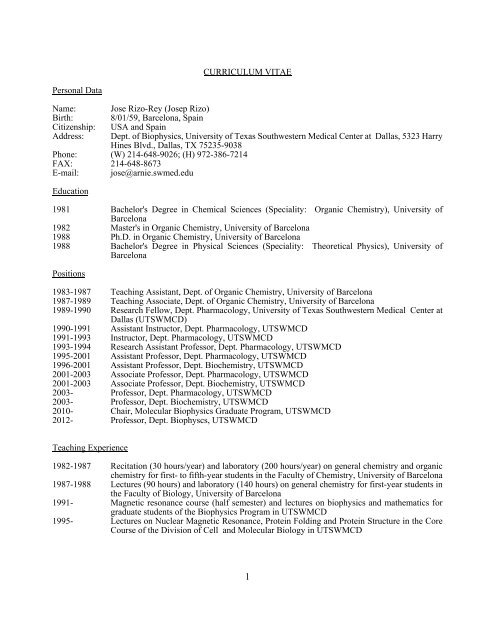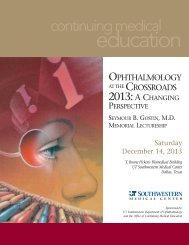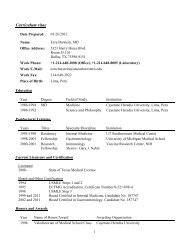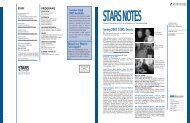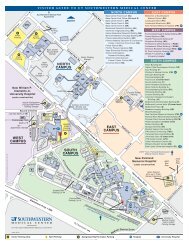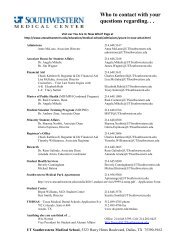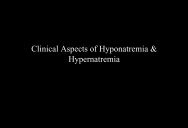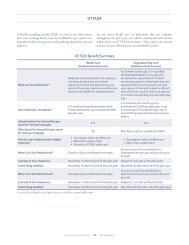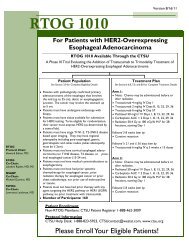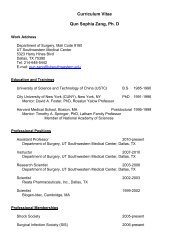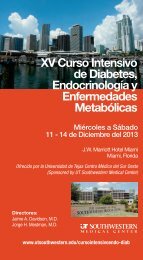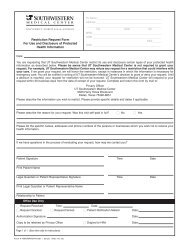Jose Rizo-Rey - UT Southwestern
Jose Rizo-Rey - UT Southwestern
Jose Rizo-Rey - UT Southwestern
Create successful ePaper yourself
Turn your PDF publications into a flip-book with our unique Google optimized e-Paper software.
CURRICULUM VITAEPersonal DataName: <strong>Jose</strong> <strong>Rizo</strong>-<strong>Rey</strong> (<strong>Jose</strong>p <strong>Rizo</strong>)Birth: 8/01/59, Barcelona, SpainCitizenship: USA and SpainAddress: Dept. of Biophysics, University of Texas <strong>Southwestern</strong> Medical Center at Dallas, 5323 HarryHines Blvd., Dallas, TX 75235-9038Phone: (W) 214-648-9026; (H) 972-386-7214FAX: 214-648-8673E-mail: jose@arnie.swmed.eduEducation1981 Bachelor's Degree in Chemical Sciences (Speciality: Organic Chemistry), University ofBarcelona1982 Master's in Organic Chemistry, University of Barcelona1988 Ph.D. in Organic Chemistry, University of Barcelona1988 Bachelor's Degree in Physical Sciences (Speciality: Theoretical Physics), University ofBarcelonaPositions1983-1987 Teaching Assistant, Dept. of Organic Chemistry, University of Barcelona1987-1989 Teaching Associate, Dept. of Organic Chemistry, University of Barcelona1989-1990 Research Fellow, Dept. Pharmacology, University of Texas <strong>Southwestern</strong> Medical Center atDallas (<strong>UT</strong>SWMCD)1990-1991 Assistant Instructor, Dept. Pharmacology, <strong>UT</strong>SWMCD1991-1993 Instructor, Dept. Pharmacology, <strong>UT</strong>SWMCD1993-1994 Research Assistant Professor, Dept. Pharmacology, <strong>UT</strong>SWMCD1995-2001 Assistant Professor, Dept. Pharmacology, <strong>UT</strong>SWMCD1996-2001 Assistant Professor, Dept. Biochemistry, <strong>UT</strong>SWMCD2001-2003 Associate Professor, Dept. Pharmacology, <strong>UT</strong>SWMCD2001-2003 Associate Professor, Dept. Biochemistry, <strong>UT</strong>SWMCD2003- Professor, Dept. Pharmacology, <strong>UT</strong>SWMCD2003- Professor, Dept. Biochemistry, <strong>UT</strong>SWMCD2010- Chair, Molecular Biophysics Graduate Program, <strong>UT</strong>SWMCD2012- Professor, Dept. Biophyscs, <strong>UT</strong>SWMCDTeaching Experience1982-1987 Recitation (30 hours/year) and laboratory (200 hours/year) on general chemistry and organicchemistry for first- to fifth-year students in the Faculty of Chemistry, University of Barcelona1987-1988 Lectures (90 hours) and laboratory (140 hours) on general chemistry for first-year students inthe Faculty of Biology, University of Barcelona1991- Magnetic resonance course (half semester) and lectures on biophysics and mathematics forgraduate students of the Biophysics Program in <strong>UT</strong>SWMCD1995- Lectures on Nuclear Magnetic Resonance, Protein Folding and Protein Structure in the CoreCourse of the Division of Cell and Molecular Biology in <strong>UT</strong>SWMCD1
Grants, Awards, Service and Honors1980-1981 Fellow, Undergraduate Research Collaborator, INAPE (Spain)1982-1983 Fellow, Ministry of Education and Science, Spain1983 Student Award, Catalan Society of Physical, Chemical and Mathematical Sciences (Spain)1983 IV Sant Albert Award for Graduate Research, School of Chemistry Graduates, CatalanChemical Association (Spain)1989-1990 Postdoctoral Fellow, Ministry of Education and Science, Spain; at <strong>UT</strong>SWMCD1994-1996 Joint Grant United Cerebral Palsy Foundation/Hearst Foundation, “Analysis of the structure andbinding properties of synaptotagmin”1995-1998 Grant Welch Foundation “Analysis of interactions between synaptic proteins by NMR”1995-2000 Grant NIH (R29) “Structural and Binding Properties of Synaptotagmin”1997-present Grant NIH (RO1) “Structure and Function of Syntaxin 1”1998-2001 Grant Welch Foundation “Structure and interactions of Vino”1998-2001 Established Investigator Award from the American Heart Association2000 Student invited speaker, ‘From genes to thoughts’ Symposium, EMBL, Heidelberg2001-2004 Grant Welch Foundation “Rab/SNARE coupling at the synapse”2001-present Member, Faculty of 10002001-present Grant NIH (RO1) “Synaptotagmin and C2-domains: Structure and Function”2002 Member, NIH Shared Instrumentation Study Section2002 High End Istrumentation Grant NIH “800 MHz NMR spectrometer”2003-2004 Grant Muscular Dystrophy Association “Structure and function of MUNC13 and RIM”2003-2006 Scientific Advisory Board, DFG-Research Center for Molecular Physiology of the Brain,Gottingen, Germany2003 Member, NIH Special Emphasis Panel to Review the MIT/Harvard Center for MagneticResonance resource grant2004-2007 Grant Welch Foundation “Mechanism of Ca 2+ -dependent Neurotransmitter Release”2004 Ad hoc member, BBCB study section from NIH2004 Ad hoc member, MDCNA2 study section from NIH2004 Member, NIH Shared Instrumentation Study Section2004 Member, NIH Special Emphasis Panel to Review Program Project Grant from UCSD2005 Member, NIH Special Emphasis Panel to Review Program Project Grant from Salk-Baylor2005 Ad hoc member, MSFC study section from NIH2005 Ad hoc member, SYN study section from NIH2006-2009 Permanent member, SYN study section from NIH2006 Visiting Lecturer of the Alberta Heritage Foundation for Medical Research2006 Molecular Biosciences Lecturer, Wichita State University2007-present Grant Welch Foundation “NMR methods to study membrane proteins in lipid bilayers”2007-2010 Human Frontiers Science Program grant “Roles of V0 and SNAREs in lipid mixing and poreopening during membrane fusion”2008- K. P. Professor, Zhejiang University, Hangzhou, China2009 Graduate Student invited Molecular and Cellular Biology seminar, University of Massachusetts,Amherst2010 Closing Lecture, 35th Lorne Conference on Protein Structure and Function, Lorne, Australia2010 Keynote Speaker, Centre for Neurogenomics and Cognition Research, Amsterdam, TheNetherlands2010 Opening Lecture, IV Spanish Portuguese Biophysical Congress, Zaragoza, Spain2012-present CPRIT MIRA Award (co-PI) “Molecular and Structural Basis of Epigenetic Regulation of AR”2012 Keynote Lecture, 8th Asian Biophysics Association Symposium, Jeju Island, South KoreaMembershipsAmerican Chemical SocietySociedad de Biofísica de España2
Annu. Rev. Biochem. 61, 387-418 (1992).14. J. <strong>Rizo</strong>, S. C. Koerber, R. J. Bienstock, J. Rivier, A. T. Hagler and L. M. Gierasch, "Conformational Analysisof a Highly Potent, Constrained Gonadotropin-Releasing Hormone Antagonist I. Nuclear Magnetic Resonance",J. Am. Chem. Soc. 114, 2852-2859 (1992).15. J. <strong>Rizo</strong>, S. C. Koerber, R. J. Bienstock, J. Rivier, L. M. Gierasch and A. T. Hagler, "Conformational Analysisof a Highly Potent, Constrained Gonadotropin-Releasing Hormone Antagonist II. Molecular DynamicsSimulations", J. Am. Chem. Soc. 114, 2860-2871 (1992).16. J. <strong>Rizo</strong>, F. Albericio, E. Giralt and E. Pedroso, "Reversible protection of lysine to facilitate the purification ofprotected peptide segments", Tetrahedron Lett. 33, 397-400 (1992).17. M. Bruch, J. <strong>Rizo</strong> and L. M. Gierasch "Impact of a Micellar Environment on the Conformations of TwoCyclic Pentapeptides", Biopolymers 32, 1741-1754 (1992).18. J. <strong>Rizo</strong>, F. Blanco, B. Kobe, M. D. Bruch and L. M. Gierasch, "Conformational Behavior of Escherichia coliOmpA Signal Peptides in Membrane Mimetic Environments", Biochemistry 32, 4881-4894 (1993).19. J. Rivier, L. Gierasch, J. <strong>Rizo</strong>, S. C. Koerber, A. Hagler, J. Porter, A. Corrigan, W. Vale and C. Rivier,"Probing the GnRH Receptor with Linear and Cyclic Analogs", in Peptide Chemistry 1992. Proceedings of the2nd Japan Symposium on Peptide Chemistry, (N. Yanaihara, Ed.), ESCOM, Leiden, The Netherlands, 313-317(1993).20. R. J. Bienstock, J. <strong>Rizo</strong>, S. C. Koerber, J. E. Rivier, A. T. Hagler and L. M. Gierasch, "ConformationalAnalysis of a Highly Potent Dicyclic Gonadotropin-Releasing Hormone Antagonist by Nuclear MagneticResonance and Molecular Dynamics", J. Med. Chem. 36, 3265-3273 (1993).21. S. J. Stradley, J. <strong>Rizo</strong> and L. M. Gierasch, "The Conformation of a Hexapeptide Substrate Bound to ProteinFarnesyltransferase", Biochemistry 32, 12586-12590 (1993).22. Z. Wang, J. Jones, J. <strong>Rizo</strong> and L. M. Gierasch, "Membrane-Bound Conformation of a Signal Peptide: aTransferred Nuclear Overhauser Effect Analysis", Biochemistry 32, 13991-13999 (1993).23. Z.-P. Liu, J. <strong>Rizo</strong> and L. M. Gierasch, "Equilibrium Folding Studies of Cellular Retinoic Acid BindingProtein, a Predominantly -Sheet Protein", Biochemistry 33, 134-142 (1994).24. J. <strong>Rizo</strong>, R. B. Sutton, J. Breslau, S. C. Koerber, J. Porter, J. E. Rivier, A. T. Hagler and L. M. Gierasch,"Defining the Active Conformation of Gonadotropin Releasing Hormone (GnRH) through Design andConformational Analysis of Constrained GnRH Analogs", in Peptides: Chemistry, Structure and Biology.Proceedings of the 13th American Peptide Symposium (R. S. Hodges and J. A. Smith, Eds.), ESCOM, Leiden,The Netherlands, pp. 766-768 (1994).25. J. <strong>Rizo</strong>, Z.-P. Liu and L. M. Gierasch, " 1 H and 15 N NMR resonance assignments and secondary structure ofcellular retinoic acid binding protein with and without bound ligand", J. Biomol. NMR. 4, 741-760 (1994).26. M. Sukumar, J. <strong>Rizo</strong>, M. Wall, L. A. Dreyfus, Y. M. Kupersztoch and L. M. Gierasch, The Structure ofEschericia Coli Heat-Stable Enterotoxin b by Nuclear Magnetic Resonance and Circular Dichroism, ProteinSci.4, 1718-1729 (1995).27. J. Rivier, G. C. Jiang, S. L. Lahrichi, J. Porter, S. C. Koerber, J. <strong>Rizo</strong>, A. Corrigan, L. Gierasch, A. Hagler,W. Vale and C. Rivier, Dose relationship between GnRH antagonists and pituitary suppression, Hum.Reprod. 11 Suppl. 3, 133-147 (1996).4
28. J. E. Rivier, G.-C. Jiang, S. C. Koerber, S. L. Lahrichi, L. Porter, J. <strong>Rizo</strong>, L. Gierasch, A. Hagler, W. Vale, M.Karten, and C. L. Rivier, GnRH antagonists: design, synthesis and side effects, Proceedings of the Treatmentwith GnRH Analogs: Controversies and Prospectives (M. Filicori, C. Flamigni, Eds.), 13-23 (1996).29. J. <strong>Rizo</strong> and M. D. Bruch, Structure Determination of Biological Macromolecules, in NMR SpectroscopyTechniques, second ed. (M. D. Bruch, Ed.), Marcel Dekker, New York, pp. 285-415 (1996).30. J. <strong>Rizo</strong>, R. B. Sutton, J. Breslau, S. C. Koerber, J. Porter, A. T. Hagler, J. E. Rivier and L. M. Gierasch, ANovel Conformation in a Highly Potent, Constrained Gonadotropin Releasing Hormone Antagonist, J. Am.Chem. Soc. 118, 970-976 (1996).31. J. <strong>Rizo</strong> and L. M. Gierasch, "Secondary Structure Elements in Peptides and Proteins: -turns, -helices and-sheets", in Encyclopedia of NMR (D. M. Grant and R. K. Harris, Eds.), John Wiley & Sons, pp. 3517-3526(1996).32. X. Shao, B. A. Davletov, R. B. Sutton, T. C. Südhof and J. <strong>Rizo</strong>, A Bipartite Ca 2+ -Binding Motif in C 2Domains of Synaptotagmin and Protein Kinase C, Science 273, 248-251 (1996).33. T. C. Südhof and J. <strong>Rizo</strong>, Synaptotagmins: C 2 -Domain Containing Proteins that Regulate MembraneTraffic, Neuron 17, 379-388 (1996).34. X. Shao, C. Li, I. Fernandez, X. Zhang, T. C. Südhof and J. <strong>Rizo</strong>, Synaptotagmin-Syntaxin Interaction: theC 2 -Domain as a Ca 2+ -Dependent Electrostatic Switch, Neuron 18,133-142 (1997).35. A. L. Osterman, H. Brooks, J. <strong>Rizo</strong> and M. A. Phillips, The role of Arg-277 in the binding of pyridoxal-5'-phosphate to Trypanosoma brucei ornithine decarboxylase, Biochemistry 36, 4558-4567 (1997).36. C. Von Poser, K. Ichtchenko, X. Shao, J. <strong>Rizo</strong> and T. C. Südhof, The Evolutionary Pressure to Inactivate: aSubclass of Synaptotagmins with an Amino Acid Substitution that Abolishes Ca 2+ Binding, J. Biol. Chem. 272,14314-14319 (1997).37. K. K. Reddy, J. <strong>Rizo</strong> and J. R. Falck, Concise Synthesis of L--Phosphatidyl-D-myo-Inositol 3,4-Biphosphate, an Intracellular Messenger, Tetrahedron Letters 38, 4729-4730 (1997).38. X. Shao, T. C. Südhof and J. <strong>Rizo</strong>, Assignment of the 1 H, 15 N and 13 C resonances of the calcium-free andcalcium-bound forms of the first C 2 -domain of synaptotagmin I, J. Biomol. NMR 10, 307-308 (1997).39. P. L. Clark, Z.-P. Liu, J. <strong>Rizo</strong> and L. M. Gierasch, Cavity formation before stable hydrogen bonding in thefolding of a -clam protein, Nature Struct. Biol. 4, 883-886 (1997).40. J. <strong>Rizo</strong>, "Peptides", in The Encyclopedia of Chemistry (J. J. Lagowski, Ed.), Macmillan, New York, NY,1145-1151 (1997).41. Z.-P. Liu, J. <strong>Rizo</strong> and L. M. Gierasch, "Protein Folding", in Bioorganic Chemistry: Peptides and Proteins (S.M. Hecht, Ed.), Oxford University Press, New York, NY, 224-257 and 493-498 (1998).42. J. <strong>Rizo</strong> * and T. C. Südhof * , C 2 -domains, structure and function of a universal Ca 2+ -binding domain, J.Biol. Chem. 273, 15879-15882 (1998).43. J. Ubach, X. Zhang, X. Shao, T. C. Südhof and J. <strong>Rizo</strong>, Ca 2+ -binding to synaptotagmin: how many Ca 2+ions bind at the tip of a C 2 -domain?, EMBO J. 17, 3921-3930 (1998).44. R. G. Kibbey, J. <strong>Rizo</strong>, L. M. Gierasch and R. G. W. Anderson, The LDL receptor clustering motif interactswith the clathrin terminal domain in a reverse turn conformation, J. Cell. Biol. 142, 59-67 (1998).5
45. X. Zhang, J. <strong>Rizo</strong> and T. C. Südhof, Mechanism of phospholipid binding by the C 2 A-domain ofsynaptotagmin I, Biochemistry 37, 12395-12403 (1998).46. X.-M. Yang, W.-F. Yu, J.-H. Li, J. Fuchs, J. <strong>Rizo</strong> and M. L. Tasayco, NMR evidence for the reassembly ofan / domain after cleavage of and -helix: implications for protein design, J. Am. Chem. Soc. 120, 7985-86(1998).47. X. Shao, I. Fernandez, T. C. Südhof and J. <strong>Rizo</strong>, Solution structures of the Ca 2+ -free and Ca 2+ -bound C 2 A-domain of synaptotagmin I: does Ca 2+ induce a conformational change?, Biochemistry 37, 16106-16115 (1998).48. I. Fernandez, J. Ubach, X. Zhang, T. C. Südhof and J. <strong>Rizo</strong>, Three-dimensional structure of anevolutionarily conserved N-terminal domain of syntaxin 1A, Cell 18, 841-849 (1998).49. J. <strong>Rizo</strong> and T. C. Südhof, Mechanics of membrane fusion, Nature Struct. Biol. 5, 839-842 (1998).50. P. L. Clark, M. Sukumar, Z. P. Liu, J. <strong>Rizo</strong>, B. F. Weston, K. S. Rotondi and L. M. Gierasch, "Folding of apredominantly -sheet", in Peptides. Proceedings of the 15th American Peptide Symposium (J. P. Tam, P. T. P.Pravin, Eds.), Kluwer, Dordrecht, The Netherlands, pp. 349-351 (1999).51. R. Baluna, J. <strong>Rizo</strong>, B. E. Gordon, V. Ghetie and E. S. Vitetta, Evidence for a structural motif in toxins andinterleukin-2 which may be responsible for binding to endothelial cells and initiating vascular leak syndrome,Proc. Natl. Acad. Sci. USA 96, 3957-3962 (1999).52. J. Ubach, J. Garcia, M. P. Nittler, T. C. Südhof and J. <strong>Rizo</strong>, Structure of the Janus-faced C 2 B-domain ofrabphilin, Nature Cell Biol. 1, 106-112 (1999).53. H. Kim, L. Esser, M. B. Hossain, D. Xia, C.-A. Yu, J. <strong>Rizo</strong>, D. Van der Helm and J. Deisenhofer, Structureof antimycin A1, a specific electron transfer inhibitor of ubiquitinol-cytochrome c oxidoreductase, J. Am.Chem. Soc. 121, 4902-4903 (1999).54. J. Hazzard, T. C. Südhof and J. <strong>Rizo</strong>, NMR analysis of the structure of synaptobrevin and of its interactionwith syntaxin, J. Biomol. NMR 14, 203-207 (1999).55. I. Dulubova, S. Sugita, S. Hill, M. Hosaka, I. Fernandez, T. C. Südhof * and J. <strong>Rizo</strong> * , A conformationalswitch in syntaxin during exocytosis, EMBO J. 18, 4372-4382 (1999).56. M. A. Contreras, J. Ubach, O. Millet, J. <strong>Rizo</strong> * and M. Pons * , Lanthanide induced orientation of a calciumbinding protein, J. Am. Chem. Soc. 121, 8947-8948 (1999).57. S. C. Koerber, J. <strong>Rizo</strong>, R. S. Struthers and J. E. Rivier, Consensus bioactive conformation of cyclic GnRHantagonists defined by NMR and molecular modeling, J. Med. Chem. 43, 819-828 (2000).58. T. Matos, J. <strong>Rizo</strong> and T. C. Südhof, “The relation of protein binding to function: what is the significance ofmunc18 and synaptotagmin binding to syntaxin 1, and where are the corresponding binding sites?”, Eur. J. CellBiol 79, 377-382 (2000).59. S. Pabst, J. Hazzard, W. Antonin, T. C. Südhof, R. Jahn, J. <strong>Rizo</strong> and D. Fasshauer, “Selective interaction ofcomplexin with the neuronal SNARE complex: determination of the binding regions”, J. Biol. Chem. 275, 19808-19818 (2000).60. R. Fernandez-Chacon, A. Königstorfer, S. H. Gerber, J. Garcia, M. F. Matos, C. F. Stevens, N. Brose, J. <strong>Rizo</strong>,C. Rosenmund and T. C. Südhof, “Synaptotagmin I functions as a Ca 2+ -regulator of release probability”, Nature410, 41-49 (2001).6
61. I. Dulubova, T. Yamaguchi, Y. Wang, T. C. Südhof and J. <strong>Rizo</strong>, “Vam3p structure reveals conserved anddivergent properties of syntaxins”, Nature Struct. Biol. 8, 258-24 (2001).62. S. H. Gerber, J. Garcia, J. <strong>Rizo</strong> and T. C. Südhof, “An unusual C 2 -domain in the active-zone protein piccolo:implications for Ca 2+ -regulation of neurotransmitter release”, EMBO J. 20, 1605-1619 (2001).63. J. Ubach, Y. Lao, I. Fernandez, D. Arac, T. C. Südhof and J. <strong>Rizo</strong>, “The C 2 B-domain of synaptotagmin I is aCa 2+ -binding module”, Biochemistry 40, 5854-5860 (2001).64. Y. Wang, I. Dulubova, J. <strong>Rizo</strong> and T. C. Südhof, “Functional analysis of conserved structural elements inyeast syntaxin Vam3p”, J. Biol. Chem. 276, 28598-28605 (2001).65. S. H. Gerber, J. <strong>Rizo</strong> and T. C. Südhof, “The top loops of the C 2 -domains from synaptotagmin andphospholipase A2 control functional specificity”, J. Biol. Chem. 276, 32288-32292 (2001).66. I. Fernandez, D. Arac, J. Ubach, S. H. Gerber, O. Shin, Y. Gao, R. G. W. Anderson, T. C. Südhof and J. <strong>Rizo</strong>,“Three-dimensional structure of the synaptotagmin 1 C 2 B-domain: synaptotagmin 1 as a phospholipid bindingmachine”, Neuron 32, 1057-1069 (2001).67. S. H. Gerber, J. <strong>Rizo</strong> and T. C. Südhof, “Role of electrostatic and hydrophobic interactions in Ca 2+ -dependentphospholipid binding by the C 2 A-domain from synaptotagmin I”, Diabetes 51 Suppl 1, S12-18 (2002).68. X. Chen, D. Tomchick, E. Kovrigin, D. Arac, M. Machius, T. C. Südhof and J. <strong>Rizo</strong>, “Three-dimensionalstructure of the complexin/SNARE complex”, Neuron 33, 397-409 (2002).69. X. Luo, Z. Tang, J. <strong>Rizo</strong> * and H. Yu * , “The Mad2 spindle checkpoint protein undergoes similar majorconformational changes upon binding to either Mad1 or Cdc20”, Molecular Cell 9, 59-71 (2002).70. J. <strong>Rizo</strong>, J. Ubach and J. Garcia, “Ca 2+ -binding mode of the C 2 A-domain of synaptotagmin”. In "Methods inMolecular Biology: Calcium-Binding Protein Protocols" (H. J. Vogel, Ed.), Humana Press, Totowa, NJ, pp. 305-316 (2002).71. J. <strong>Rizo</strong> and T. C. Südhof, “C 2 -domains”. In “The Encyclopedia of Molecular Medicine” (T. E. Creighton,Ed.), John Wiley & Sons, New York, NY, pp. 708-711 (2002).72. O. Millet, P. Bernado, J. Garcia, J. <strong>Rizo</strong> * and M. Pons * , “NMR measurement of the off-rate from the firstcalcium-binding site of the synaptotagmin I C 2 A-domain”, FEBS Lett. 516, 93-96 (2002).73. T. Yamaguchi, I. Dulubova, S.-W. Min, X. Chen, J. <strong>Rizo</strong> and T. C. Südhof, “Sly1 binds to the Golgi and ERsyntaxins via a conserved N-terminal peptide motif”, Developmental Cell 2, 295-305 (2002).74. W. C. Wigley, M. J. Corboy, T. D. Cutler, P. H. Thibodeau, J. Oldan, M. G. Lee, J. <strong>Rizo</strong>, J. F. Hunt and P. J.Thomas, “Protein sequence that can encode native secondary structure by disfavoring alternate conformations”,Nature Struct. Biol. 9, 381-388 (2002).75. J. Lu, J. Garcia, I. Dulubova, T. C. Südhof and J. <strong>Rizo</strong>, “Solution structure of the Vam7p PX domain”,Biochemistry 41, 5956-5962 (2002).76. O. Shin, J. <strong>Rizo</strong> and T. C. Südhof, “Synaptotagmin function in dense core vesicle exocytosis studied incracked PC12 cells”, Nat. Neurosci. 5, 649-656 (2002).77. I. Dulubova, T. Yamaguchi, Y. Gao, S. W. Min, I. Huryeva, T. C. Südhof and J.<strong>Rizo</strong>, “How Tlg2p/syntaxin16 ‘snares’ Vps45p”, EMBO J. 21, 3620-3631 (2002).7
78. W. Antonin, I. Dulubova, D. Araç, S. Pabst, J. Plitzner, J. <strong>Rizo</strong> and R. Jahn, “The N-terminal domains ofsyntaxin 7 and vti1b form three-helix bundles that differ in their ability to regulate SNARE complex assembly”,J. Biol. Chem. 277, 36449-36456 (2002).79. J. <strong>Rizo</strong> * and T. C. Südhof * , “SNAREs and munc18 in synaptic vesicle fusion”, Nature Rev. Neurosci 3., 641-653 (2002).80. R. Fernandez-Chacon, O. Shin, A. Königstorfer, M. F. Matos, A. C. Mayer, J. Garcia, S. H. Gerber, J. <strong>Rizo</strong>,T. C. Südhof and C. Rosenmund, “Structure/function analysis of Ca 2+ -binding to the C 2 A-domain ofsynaptotagmin I”, J. Neurosci. 22, 8438-8446 (2002).81. I. Dulubova, T. Yamaguchi, D. Araç, H. Li, I. Huryeva, S.-W. Min, J. <strong>Rizo</strong> * and T. C. Südhof * , “Convergenceand divergence in the mechanism of SNARE binding by Sec1/Munc18-like proteins”, Proc. Natl. Acad. Sci. USA100, 32-37 (2003).82. D. Araç, T. Murphy and J. <strong>Rizo</strong>, “Facile detection of protein-protein interactions by one-dimensional NMRspectroscopy”, Biochemistry 42, 2774-2780 (2003).83. T. C. Südhof and J. <strong>Rizo</strong>, “C 2 -domains in Ca 2+ signaling”. In “Handbook of Cell Signaling” Vol. 2 (M.Berridge, Ed.), Elsevier, San Diego, CA, pp. 95-100 (2003).84. S. Chandra, X. Chen, J. <strong>Rizo</strong>, R. Jahn and T. C. Südhof, “A broken -helix in folded -synuclein”, J. Biol.Chem. 278, 15313-15318 (2003).85. J. E. Smallshaw, V. Ghetie, J. <strong>Rizo</strong>, J. R. Fulmer, L. L. Trahan, M.-A. Ghetie and E. S. Vitetta, “Geneticengineering of an immunotoxin to eliminate pulmonary vascular leak in mice”, Nat. Biotechnol. 21, 387-391(2003).86. J. <strong>Rizo</strong>, “SNARE function revisited”, Nat. Struct. Biol. 10, 417-419 (2003).87. N. Jarousse, J. D. Wilson, D. Araç, J. <strong>Rizo</strong> and R. B. Kelly, “Endocytosis of synaptotagmin 1 is mediated bya novel, tryptophan-containing motif”, Traffic 4, 468-478 (2003).88. M. F. Matos, K. Mukherjee, X. Chen, J. <strong>Rizo</strong> and T. C. Südhof, “Evidence for SNARE zippering duringCa 2+ -triggered exocytosis in PC12 cells”, Neuropharmacology 45, 777-786 (2003).89. J. <strong>Rizo</strong>, “C 2 -domain proteins involved in membrane traffic”. In “Handbook of Metalloproteins” Vol. 3 (A.Messerschmidt, W. Bode and M. Cygler, Eds.), Wiley, Chichester, pp. 599-613 (2004).90. J. Garcia, S. H. Gerber, S. Sugita, T. C. Südhof and J. <strong>Rizo</strong>, “A conformational switch in the piccolo C 2 A-domain regulated by alternative splicing”, Nat. Struct. Molec. Biol. 11, 45-53 (2004).91. O. Shin, A. Maximov, B. K. Lim, J. <strong>Rizo</strong> and T. C. Südhof, “Unexpected Ca 2+ -binding properties ofsynaptotagmin9 ”, Proc. Natl. Acad. Sci. USA 101, 2554-2559 (2004).92. X. Luo, Z. Tang, G. Xia, K. Wassmann, T. Matsumoto, J. <strong>Rizo</strong> * and H. Yu * , “The Mad2 spindle checkpointprotein has two distinct natively folded states”, Nat. Struct. Molec. Biol. 11, 338-345 (2004).93. H. Dai, O.-H. Shin, M. Machius, D. R. Tomchick, T. C. Südhof and J. <strong>Rizo</strong>, “Structural basis for theevolutionary inactivation of Ca 2+ binding to synaptotagmin 4”, Nat. Struct. Molec. Biol. 11, 844-849 (2004).94. I. Dulubova, A. Ho, I. Huryeva, T. C. Südhof and J. <strong>Rizo</strong>, “Three-dimensional structure of an independentlyfolded extracellular domain of human amyloid-beta precursor protein”, Biochemistry 43, 9583-9588 (2004).8
95. G. Xia, X. Luo, T. Habu, J. <strong>Rizo</strong>, T. Matsumoto and H. Yu, “Conformation-specific binding of p31 cometantagonizes the function of Mad2 in the spindle checkpoint”, EMBO J. 23, 3133-3143 (2004).96. D. Araç, I. Dulubova, J. Pei, I. Huryeva, N. V. Grishin and J. <strong>Rizo</strong>, “Three-dimensional structure of the rSly1N-terminal domain reveals a conformational change induced by binding to Syntaxin 5”, J. Mol. Biol. 346, 589-601 (2005).97. N. Shen, O. Guryev and J. <strong>Rizo</strong>, “Intramolecular occlusion of the dyacylglycerol-binding site in the C 1domain of munc13-1”, Biochemistry 44, 1089-1096 (2005).98. X. Chen, J. Tang, T. C. Südhof and J. <strong>Rizo</strong>, “Are the neuronal SNAREs Ca 2+ sensors?”, J. Mol. Biol. 347,145-158 (2005).99. I. Dulubova, X. Lou, J. Lu, I. Huryeva, A. Alam, R. Schneggenburger, T. C. Südhof and J. <strong>Rizo</strong>, “AMunc13/RIM/Rab3 tripartite complex: from priming to plasticity?”, EMBO J. 24, 2839-2850 (2005).100. J. Basu, N. Shen, I. Dulubova, J. Lu, R. Guan, O. Guryev, N. V. Grishin, C. Rosenmund and J. <strong>Rizo</strong>,“Identification of a minimal domain responsible for Munc13 activity”, Nat. Struct. Molec. Biol. 12, 1017-1018(2005).101. J. Lu, H. Li, Y. Wang, T. C. Südhof and J. <strong>Rizo</strong>, “Solution structure of the RIM1 PDZ domain in complexwith an ELKS1b C-terminal peptide”, J. Mol. Biol. 352, 455-466 (2005).102. H. Dai, D. R. Tomchick, J. Garcia, T. C. Südhof, M. Machius and J. <strong>Rizo</strong>, “Crystal structure of the RIM2C 2 A-domain at 1.4 Å resolution”, Biochemistry 44, 13533-13542 (2005).103. J. S. Rhee, L. Li, O.-H. Shin, J.C. Rah, J. <strong>Rizo</strong>, T. C. Südhof and C. Rosenmund, “Augmentingneurotransmitter release by enhancing the apparent Ca2+-affinity of synaptotagmin 1”, Proc. Natl. Acad. Sci.USA 102, 18664-18669 (2005).104. A. D. Ferguson, V. M. Labunskyy, D. E. Fomenko, D. Arac, Y. Chelliah, C. A. Amezcua, J. <strong>Rizo</strong>, V. N.Gladyshev, and J. Deisenhofer, "NMR structures of the selenoproteins Sep15 and SelM reveal redox activity ofnew thioredoxin-like family”, J. Biol. Chem. 281, 3536-3543 (2006).105. X. Chen, D. Araç, T.-M. Wang, C. J. Gilpin, J. Zimmerberg and J. <strong>Rizo</strong>, “SNARE-mediated lipid mixingdepends on the physical state of the vesicles”, Biophys. J. 90, 2062-2074 (2006).106. D. Araç, X. Chen, H. A. Khant, J. Ubach, S. J. Ludtke, M. Kikkawa, A. E. Johnson, W. Chiu, T. C. Südhofand J. <strong>Rizo</strong>, “Close membrane-membrane proximity induced by Ca 2+ -dependent multivalent binding ofsynaptotagmin 1 to phospholipids”, Nat. Struct. Molec. Biol. 13, 209-217 (2006).107. Deak,F., Shin,O.H., Tang,J., Hanson,P., Ubach,J., Jahn,R., <strong>Rizo</strong>,J., Kavalali,E.T., and Sudhof,T.C.Rabphilin regulates SNARE-dependent re-priming of synaptic vesicles for fusion. EMBO J. 25, 2856-2866(2006).108. Li,L., Shin,O.H., Rhee,J.S., Arac,D., Rah,J.C., <strong>Rizo</strong>,J., Sudhof,T., and Rosenmund,C. Phosphatidylinositolphosphates as co-activators of Ca2+ binding to C2 domains of synaptotagmin 1. J. Biol. Chem. 281, 15845-15852 (2006).109. Lu,J., Machius,M., Dulubova,I., Dai,H., Sudhof,T.C., Tomchick,D.R., and <strong>Rizo</strong>,J. Structural Basis for aMunc13-1 Homodimer to Munc13-1/RIM Heterodimer Switch. PLoS. Biol. 4, 1159-1172 (e192) (2006).9
110. Pang,Z.P., Sun,J., <strong>Rizo</strong>,J., Maximov,A., and Sudhof,T.C. Genetic analysis of synaptotagmin 2 inspontaneous and Ca2+-triggered neurotransmitter release. EMBO J. 25, 2039-2050 (2006).111. <strong>Rizo</strong>,J., Chen,X., and Arac,D. Unraveling the mechanisms of synaptotagmin and SNARE function inneurotransmitter release. Trends Cell Biol. 16, 339-350 (2006).112. Tang, J., Maximov, A., Shin, O.-H., Dai, H., <strong>Rizo</strong>, J. and Sudhof, T. C. A complexin/synaptotagmin-1switch controls fast synaptic vesicle exocytosis. Cell 126, 1175-1187 (2006).113. <strong>Rizo</strong>, J. Illuminating membrane fusion. Proc. Natl. Acad. Sci. USA 103, 19611-19612 (2006).114. Dulubova, I., Khvotchev, M., Liu, S., Huryeva, I., Südhof, T. C. * and <strong>Rizo</strong>, J. * Munc18-1 binds directlyto the neuronal SNARE complex. Proc. Natl. Acad. Sci. USA 104, 2697-2702 (2007).115. J. <strong>Rizo</strong>, “Proteinas SNARE”, Investigacion y Ciencia 364, 30-31 (2007).116. Dai, H., Shen, N., Araç, D. and <strong>Rizo</strong>, J. A quaternary SNARE-synaptotagmin-Ca 2+ -phospholipidcomplex in neurotransmitter release. J. Mol. Biol. 367, 848-863 (2007).117. Guan, R., Dai, H., Tomchick, D. R., Dulubova, I., Machius, M., Südhof, T. C. and <strong>Rizo</strong>, J. Crystalstructure of the RIM1 C 2 B domain at 1.7 Å resolution, Biochemistry 46, 8988-8998 (2007).118. Cavanaugh, L. F., Chen, X., Richardson, B. C., Ungar, D., Pelczer, I., <strong>Rizo</strong>, J. and Hughson, F. M.Structural analysis of conserved oligomeric Golgi complex subunit 2, J. Biol. Chem. 282, 23418-23426(2007).119. Roggero, C. M., De Blas, G. A., Dai, H., Tomes, C. N., <strong>Rizo</strong>, J. and Mayorga, L. S.Complexin/synaptotagmin interplay controls acrosomal exocytosis. J. Biol. Chem. 282, 26335-26343 (2007).120. <strong>Rizo</strong>, J. and Dai, H. How much can SNAREs flex their muscles? Nat. Struct. Molec. Biol. 14, 880-882(2007).121. Xue, M., Reim, K., Chen, X., Chao, H.-T., Deng, H., <strong>Rizo</strong>, J., Brose, N. and Rosenmund, C. Distinctdomains of complexin I differentially regulate neurotransmitter release. Nat. Struct. Molec. Biol. 14, 949-958(2007).122. Yang, M., Li, B., Tomchick, D. R., Machius, M., <strong>Rizo</strong>, J., Yu, H. and Luo, X. p31(comet) blocks Mad2activation through structural mimicry. Cell 131, 744-755 (2007).123. Khvotchev, M., Dulubova, I., Sun, J., Dai, H., <strong>Rizo</strong>, J. and Südhof, T. C. Dual Modes of Munc18-1/SNARE Interactions Are Coupled by Functionally Critical Binding to syntaxin-1 N-terminus. J. Neurosci.27, 12147-12155 (2007).124. Guan, R., Dai, H. and <strong>Rizo</strong>, J. Binding of the Munc13-1 MUN domain to membrane-anchored SNAREcomplexes. Biochemistry 47, 1474-1481 (2008).125. Yang, M., Li, B., Liu, C.-J., Tomchick, D. R., Machius, M., <strong>Rizo</strong> J., Yu, H. and Luo, X. Insights intoMad2 regulation in the spindle checkpoint revealed by structure of the symmetric Mad2 dimer. PloS Biol. 6,643-655 (e50) (2008).10
126. <strong>Rizo</strong>, J. A dynamic t-SNARE complex. Structure 16, 163-165 (2008).127. Maximov, A., Lao, Y., Li, H., Chen, X., <strong>Rizo</strong>, J., Sorensen, J. B. and Sudhof, T. C. Genetic analysis ofsynaptotagmin-7 function in synaptic vesicle exocytosis. Proc. Natl. Acad. Sci. U.S.A. 105, 3986-3991(2008).128. Chen, X., Lu, J., Dulubova, I. and <strong>Rizo</strong>, J. NMR analysis of the closed conformation of syntaxin-1. J.Biomol. NMR 41, 43-54 (2008).129. <strong>Rizo</strong>, J. * and Rosenmund, C. * Synaptic vesicle fusion. Nat. Struct. Mol. Biol. 15, 665-674 (2008).130. Gerber, S. H., Rah, J.-C., Min, S.W., Liu, X., de Wit, H., Dulubova, I., Meyer, A. C., <strong>Rizo</strong>, J.,Arancillo, M., Hammer, R. E., Verhage, M., Rosenmund, C. and Südhof, T. C. Conformational switch ofSyntaxin-1 controls synaptic vesicle fusion, Science 321, 1507-1510 (2008).131. Xue, M., Ma, C., Craig, T. K., Rosenmund, C. * and <strong>Rizo</strong>, J. * The Janus-faced nature of the C 2 B domainis fundamental for synaptotagmin-1 function. Nat. Struct. Mol. Biol. 15, 1160-1168 (2008).132. <strong>Rizo</strong>, J. “SNAREs”. In “Encyclopedia of Neuroscience” (L. Squire, Editor), Oxford: Academic Press,Vol. 9, 11-19 (2009).133. Deák. F., Xu, Y., Chang, W.-P., Dulubova, I., Khvotchev, M., Liu, X., Sudhof, T. C. * and <strong>Rizo</strong>, J. *Munc18-1 binding to the neuronal SNARE complex controls synaptic vesicle priming. J. Cell Biol. 184, 751-764 (2009).134. Pei, J., Ma, C., <strong>Rizo</strong>, J. and Grishin, N.V. Remote homology between Munc13 MUN domain and vesicletethering complexes. J. Mol. Biol. 391, 509-517 (2009).135. Shin, O.H., Xu, J., <strong>Rizo</strong>, J. and Sudhof, T. C. Differential but convergent functions of Ca 2+ binding tosynaptotagmin-1 C 2 domains mediate neurotransmitter release. Proc. Natl. Acad. Sci. USA 106, 16469-16474(2009).136. <strong>Rizo</strong>, J. “Synaptic vesicle fusion machinery”. In “Molecular Biology of Assemblies and Machines” (R.Perham, L. Johnson, A. Steven, W. Baumeister), Garland Science, in press.137. Shin, O.-H., Lu, J., Rhee, J.-S., Tomchick, D. R., Pang, Z. P., Wojcik, S. M., Camacho-Perez, M., Brose,N., Machius, M., <strong>Rizo</strong> J. * , Rosenmund, C. * and Sudhof, T. C. * Munc13 C 2 B domain –an activity-dependentCa 2+ -regulator of synaptic exocytosis. Nat. Struct. Mol. Biol. 17, 280-288 (2010).138. Xue, M., Craig, T.K., Xu, J., Chao, H.-T., <strong>Rizo</strong>, J. * and Rosenmund, C. * Binding of the Complexin Nterminus to the SNARE complex C terminus potentiates synaptic vesicle fusogenicity. Nat. Struct. Mol. Biol.17, 568-575 (2010).139. Xu, Y., Su, L. and <strong>Rizo</strong>, J. Binding of Munc18-1 to synaptobrevin and to the SNARE four-helix bundle.Biochemistry 49, 1568-1576 (2010).140. <strong>Rizo</strong>, J. Synaptotagmin-SNARE coupling enlightened. Nat. Struct. Mol. Biol. 17, 260-262 (2010).11
141. Carr, C. M. and <strong>Rizo</strong>, J. At the junction of SNARE and SM protein function. Curr. Opin. Cell Biol. 22,488-495 (2010).142. Sheard, L.B., Tan, X., Mao, H., Withers, J., Nissan, G.B., Hinds, T.R., Hsu, F.-F., Sharon, M., Browse, J.,He, S.Y., <strong>Rizo</strong>, J., Howe, G.A. and Zheng, N. Jasmonate perception by inositol-phosphate-potentiated COI1-JAZ co-receptor. Nature 468, 400-405 (2010).143. Xue, M., Craig, T.K., Shin, O.-H., Li, Y., Brautigam, C.A., Tomchick, D.R., Sudhof, T.C., Rosenmund,C. * and <strong>Rizo</strong>, J. * Structural and mutational analysis of functional differentiation between synaptotagmins-1 and7. PloS One 5, e12544 (2010).144. Citri, A., Bhattacharyya, S., Ma, C., Morishita, W., Fang, S., <strong>Rizo</strong>, J. and Malenka, R.C. Calcium Bindingto PICK1 is Essential for the Intracellular Retention of AMPA Receptors Underlying long-term depression. J.Neurosci. 30, 16437-16452 (2010).145. Pan, Y.-R., Lou, Y.-C., Seven, A.B., <strong>Rizo</strong>, J. and Chen, C. NMR structure and calcium-binding propertiesof the tellurite resistance protein TerD from Klebsiella pneumoniae. J. Mol. Biol. 405, 1188-1201 (2011).146. Kaeser, P.S., Deng, L., Wang, Y., Dulubova, I., Liu, X., <strong>Rizo</strong> J. and Sudhof, T.C. RIM proteins tetherCa 2+ -channels to presynaptic active zones via a direct PDZ-domain interaction. Cell 144, 282-295 (2011).147. Ma, C., Li, W., Xu, Y. and <strong>Rizo</strong>, J. Munc13 mediates the transition from the closed syntaxin/Munc18complex to the SNARE complex, Nat. Struct. Mol. Biol. 18, 542-549 (2011).148. Xu, Yi, Seven, A.B., Su, L., Jiang, Q.-X. and <strong>Rizo</strong>, J. Membrane bridging and hemifusion by denaturedMunc18. PloS One 6, e22012 (2011).149. Brewer, K.D., Li, W., Horne, E.B. and <strong>Rizo</strong> J. Reluctance to membrane binding enables accessibility ofthe synaptobrevin SNARE motif for SNARE complex formation. Proc. Natl. Acad. Sci. USA 108, 12723-12728(2011).150. Sudhof, T.C. and <strong>Rizo</strong> J. Synaptic vesicle exocytosis, in ‘The synapse’ (Ed. T. C. Sudhof), Cold SpringHarb. Perspect. Biol. 3, a005637 (2011).151. Li, W., Ma, C., Guan, R., Xu, Y., Tomchick, D.R. * and <strong>Rizo</strong>, J. * The crystal structure of a Munc13 C-terminal module exhibits a remarkable similarity to vesicle tethering factors. Structure 19, 1443-1455 (2011).152. Matos, M.F., Xu, Y., Dulubova, I., Otwinowski, Z., Richardson, J.M., Tomchick, D.R., <strong>Rizo</strong>, J. and Ho,A. Autoinhibition of Mint1 adaptor protein regulates amyloid precursor protein binding and processing. Proc.Natl. Acad. Sci. USA, in press (2012).153. <strong>Rizo</strong>, J. and Sudhof, T.C. The membrane fusion enigma: SNAREs, Sec1/Munc18 proteins and theiraccomplices – guilty as charged? Annu. Rev. Cell Dev. Biol. 28, 279-308 (2012).154. <strong>Rizo</strong>, J., Rosen, M.K. and Gardner, K.H. Enlightening molecular mechanisms through study of proteininteractions. J. Mol. Cell Biol. 4, 270-283 (2012).155. <strong>Rizo</strong>, J. Staging membrane fusion, Science 337, 1300-1301 (2012).12
156. Ma, C. * , Su, L., Seven, A. B., Xu, Y. and <strong>Rizo</strong>, J. * Reconstitution of the vital functions of Munc18 andMunc13 in neurotransmitter release, Science 339, 421-425 (2013).157. Zhou, A., Brewer, K.D., and <strong>Rizo</strong>, J. Analysis of SNARE complex/Synaptotagmin-1 Interactions by OnedimensionalNMR Spectroscopy. Biochemistry 52, 3446-3456 (2013).158. Xu, J., Brewer, K. D., Perez-Castillejos, R., and <strong>Rizo</strong>, J. Subtle interplay between synaptotagminandcomplexin-binding to the SNARE complex. J. Mol. Biol., in press.159. Seven, A. B., Brewer, K. D., Shi, L., Jiang, Q.-X., and <strong>Rizo</strong>, J. Prevalent mechanism of membranebridging by synaptotagmin-1. Proc. Natl. Acad. Sci. USA, in press.*Co-corresponding authors13


